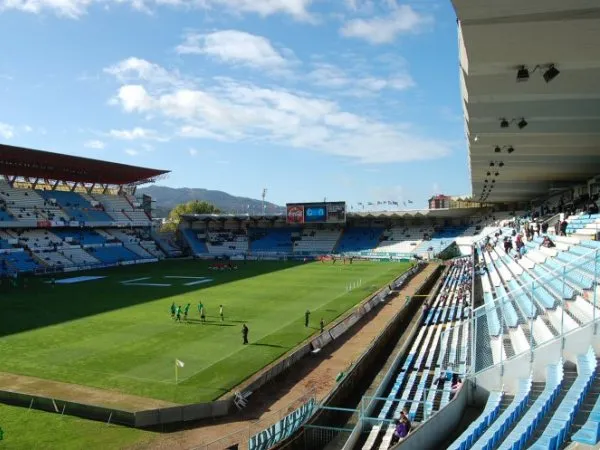- BETTING TIPS
- BETTING TIPS NAVIGATIONS
 Premier League
Premier League FA Cup
FA Cup League Cup
League Cup La Liga
La Liga Copa del Rey
Copa del Rey Super Cup
Super Cup Champions League
Champions League Europa League
Europa League Europa Conference League
Europa Conference League World Cup
World Cup Euro Championship
Euro Championship Nations League
Nations League Africa Cup of Nations
Africa Cup of Nations Copa America
Copa America International Friendly
International Friendly Confederations Cup
Confederations Cup Serie A
Serie A Coppa Italia
Coppa Italia Super Cup
Super Cup Bundesliga
Bundesliga Ligue 1
Ligue 1 DFB Pokal
DFB Pokal Super Cup
Super Cup Malaysia Super League
Malaysia Super League Coupe de France
Coupe de France Trophée des Champions
Trophée des Champions Pro League
Pro League
- Teams
- TEAMS NAVIGATIONS
 Premier League
Premier League FA Cup
FA Cup League Cup
League Cup La Liga
La Liga Copa del Rey
Copa del Rey Super Cup
Super Cup Champions League
Champions League Europa League
Europa League Europa Conference League
Europa Conference League World Cup
World Cup Euro Championship
Euro Championship Nations League
Nations League Africa Cup of Nations
Africa Cup of Nations Copa America
Copa America International Friendly
International Friendly Confederations Cup
Confederations Cup Serie A
Serie A Coppa Italia
Coppa Italia Super Cup
Super Cup Bundesliga
Bundesliga Ligue 1
Ligue 1 DFB Pokal
DFB Pokal Super Cup
Super Cup Malaysia Super League
Malaysia Super League Coupe de France
Coupe de France Trophée des Champions
Trophée des Champions Pro League
Pro League
- Fixtures & Results
- Fixtures & Results NAVIGATIONS
 Premier League
Premier League FA Cup
FA Cup League Cup
League Cup La Liga
La Liga Copa del Rey
Copa del Rey Super Cup
Super Cup Champions League
Champions League Europa League
Europa League Europa Conference League
Europa Conference League World Cup
World Cup Euro Championship
Euro Championship Nations League
Nations League Africa Cup of Nations
Africa Cup of Nations Copa America
Copa America International Friendly
International Friendly Confederations Cup
Confederations Cup Serie A
Serie A Coppa Italia
Coppa Italia Super Cup
Super Cup Bundesliga
Bundesliga Ligue 1
Ligue 1 DFB Pokal
DFB Pokal Super Cup
Super Cup Malaysia Super League
Malaysia Super League Coupe de France
Coupe de France Trophée des Champions
Trophée des Champions Pro League
Pro League
- Tables
- Tables NAVIGATIONS
 Premier League
Premier League FA Cup
FA Cup League Cup
League Cup La Liga
La Liga Copa del Rey
Copa del Rey Super Cup
Super Cup Champions League
Champions League Europa League
Europa League Europa Conference League
Europa Conference League World Cup
World Cup Euro Championship
Euro Championship Nations League
Nations League Africa Cup of Nations
Africa Cup of Nations Copa America
Copa America International Friendly
International Friendly Confederations Cup
Confederations Cup Serie A
Serie A Coppa Italia
Coppa Italia Super Cup
Super Cup Bundesliga
Bundesliga Ligue 1
Ligue 1 DFB Pokal
DFB Pokal Super Cup
Super Cup Malaysia Super League
Malaysia Super League Coupe de France
Coupe de France Trophée des Champions
Trophée des Champions Pro League
Pro League
- News
- News NAVIGATIONS
 Premier League
Premier League FA Cup
FA Cup League Cup
League Cup La Liga
La Liga Copa del Rey
Copa del Rey Super Cup
Super Cup Champions League
Champions League Europa League
Europa League Europa Conference League
Europa Conference League World Cup
World Cup Euro Championship
Euro Championship Nations League
Nations League Africa Cup of Nations
Africa Cup of Nations Copa America
Copa America International Friendly
International Friendly Confederations Cup
Confederations Cup Serie A
Serie A Coppa Italia
Coppa Italia Super Cup
Super Cup Bundesliga
Bundesliga Ligue 1
Ligue 1 DFB Pokal
DFB Pokal Super Cup
Super Cup Malaysia Super League
Malaysia Super League Coupe de France
Coupe de France Trophée des Champions
Trophée des Champions Pro League
Pro League
- Live ScoresLive
Celta Vigo
Spain| Country | : | Spain |
| League | : | |
| Founded | : | 1923 |
| Venue | : | Abanca-Balaídos |
| Coach | : | Aday (Serbia) |
Venue

Abanca-Balaídos
| City | : | Vigo |
| Capacity | : | 31,800 |
| Surface | : | Grass |
Celta de Vigo, one of Spain’s most storied football clubs, has a rich history and a passionate fan base that spans generations. Based in the coastal city of Vigo in the Galicia region of northwest Spain, the club is known for its deep ties to the local culture and history. Founded in 1923, Celta Vigo has established itself as one of Spain’s prominent football clubs, competing regularly in La Liga, the country's top football division.
Throughout its history, Celta Vigo has faced both ups and downs, but it has always been a club that embodies resilience and pride. Known for its attacking football, commitment to youth development, and solid performances in domestic and European competitions, Celta has made its mark on Spanish football.
This comprehensive guide explores the history of Celta Vigo, highlighting key moments, memorable players, and the club’s journey from its inception to the present day. It also takes a look at the current state of the club, its performance in recent years, and its ambitions for the future.
Match Predictions
- Valencia vs. Levante Predictions & Betting Tips on Nov 22 - 04:00 AM
- Alaves vs. Celta Vigo Predictions & Betting Tips on Nov 22 - 21:00 PM
- Barcelona vs. Athletic Club Predictions & Betting Tips on Nov 22 - 23:15 PM
- Osasuna vs. Real Sociedad Predictions & Betting Tips on Nov 23 - 01:30 AM
- Villarreal vs. Mallorca Predictions & Betting Tips on Nov 23 - 04:00 AM
The Birth of Celta Vigo – Early Years in Spanish Football
Celta Vigo was founded on March 23, 1923, when two local teams, Real Vigo Sporting and Fortuna Vigo, merged to create a unified team. The club's name, "Celta," is derived from the Celts, the ancient people who once inhabited the Galicia region. This historic name reflects the club’s deep roots in the Galician culture.
In the early years, Celta Vigo played in regional leagues, but by the late 1920s, they began to make a name for themselves on the national stage. The team gained promotion to Spain’s top tier in the early 1930s and began competing in La Liga for the first time.
Though Celta Vigo's early years were marked by struggles to remain in the top division, they continued to grow in stature and skill. The team’s resilience helped them carve out an identity in Spanish football, especially within Galicia, where football became a central part of the region’s cultural identity.
The Rise of Celta Vigo – The 1940s and 1950s
During the 1940s and 1950s, Celta Vigo began to establish itself as a strong presence in Spanish football. The club enjoyed a period of consistent performance in La Liga, maintaining a spot in the top division year after year. This was a time when Celta Vigo first gained significant recognition, building a solid reputation in the national league.
In the 1950s, the club experienced its first notable successes, with standout performances from key players like Manuel "Manolo" Fernández and José Luis Villarino. Their contributions played a significant role in establishing Celta Vigo as a competitive side in Spanish football.
By the 1950s, Celta Vigo had begun to make regular appearances in the Copa del Rey, Spain’s most prestigious domestic cup competition. Although they didn’t win it during this period, the club was slowly becoming a force to be reckoned with in Spanish football.
A Golden Era – The 1960s and 1970s
The 1960s and 1970s were a defining period in Celta Vigo’s history, as the club began to establish itself as a true competitor in Spain’s top division. Celta reached new heights during this time, securing its place as one of La Liga’s strongest teams.
European Competition
In the early 1960s, Celta Vigo made its first foray into European competitions. They participated in the Inter-Cities Fairs Cup (a precursor to the UEFA Cup, now the Europa League), showcasing their growing ability to compete against top teams across Europe. This marked a major milestone in the club’s history and established Celta Vigo’s international presence.
While Celta didn’t win any European trophies during this period, the club laid the groundwork for future European campaigns. The 1960s and 1970s also saw an increase in the quality of players joining the club, raising the team’s profile both domestically and abroad.
A Difficult Decade – The 1980s and Early 1990s
Following their successes in the 1960s and 1970s, the 1980s and early 1990s were challenging years for Celta Vigo. The club faced financial difficulties and periods of underperformance, leading to relegation from La Liga in 1986. This marked the start of a period of uncertainty for the club, as they bounced between the top and second divisions.
Despite the challenges, Celta Vigo managed to recover and returned to La Liga in the 1990s. The club's commitment to youth development and a strong scouting network helped them regain their place in Spain’s top division. Celta’s loyal fan base stood by the club through these tough times, and the club began to build for the future.
Celta Vigo in the Modern Era – Resurgence and European Glory
The late 1990s and early 2000s saw a resurgence for Celta Vigo, as the club once again became a regular fixture in La Liga. Under the management of Fernando Vázquez, Celta achieved significant success in Spain’s top tier.
The 2000-2001 Season: A Breakthrough Year
One of the most memorable seasons in Celta Vigo's modern history was the 2000-2001 season, when the club secured a top-four finish in La Liga, qualifying for the UEFA Champions League for the first time in their history. This was an extraordinary achievement for a club that had spent much of the previous decade fighting relegation.
During this period, Celta Vigo had a number of standout players, including Iago Aspas, Catanha, and Valeri Karpin, who played crucial roles in the club’s success. Their dynamic attacking play and solid defensive performances allowed Celta to challenge the bigger teams in Spain, cementing their place among the top clubs in the country.
European Nights
Celta Vigo’s first participation in European competitions was nothing short of spectacular. Their run in the UEFA Cup during the 2003-2004 season saw them reach the semifinals, where they faced the mighty Valencia CF. Although they were ultimately knocked out, Celta Vigo’s European adventure showcased their potential to compete at the highest level.
Recent Seasons – Challenges and Ambitions
In recent years, Celta Vigo has continued to be a consistent presence in La Liga, though the club has faced financial difficulties and managerial changes. Despite battling relegation at times, the club has maintained its place in Spain’s top division and continues to develop young talent through its academy.
Key Players of the Modern Era
-
Iago Aspas: One of the club's most iconic players, Iago Aspas has been the heart and soul of Celta Vigo for several seasons. His goalscoring ability and leadership have made him a fan favorite and one of La Liga’s top forwards. Aspas has consistently been one of Celta’s standout performers in recent seasons, playing a crucial role in keeping the club competitive.
-
Nolito: A talented winger, Nolito enjoyed a successful spell at Celta Vigo in the mid-2010s, contributing significantly to the team’s attacking play. His ability to score and assist made him one of the club’s key players during his time at the club.
Managerial Changes and Future Outlook
Celta Vigo has experienced several managerial changes in recent seasons, with different coaches trying to find the right formula to push the team forward. However, the club’s strong foundations, passionate fan base, and commitment to developing young players from their academy make them a club with a bright future.
Balaídos Stadium – The Heart of Celta Vigo
Balaídos Stadium, located in Vigo, is the iconic home of Celta Vigo. With a capacity of over 29,000, the stadium is known for its passionate atmosphere and loyal supporters, who make the stadium one of the most challenging places to play in La Liga.
The stadium has undergone several renovations over the years to meet modern standards, but it retains the rich history and emotional connection that fans have with the club. Balaídos is the place where Celta’s most memorable moments have occurred, and it continues to be a fortress for the team.
Conclusion
Celta Vigo has built a legacy of resilience, passion, and competitiveness throughout its nearly 100-year history. From its early days in regional leagues to its rise to prominence in Spanish football, Celta Vigo has faced challenges, but it has always remained a club that refuses to back down. With a strong focus on youth development and a loyal fan base, the club is well-positioned to continue its journey in La Liga.
Celta Vigo’s future looks promising, with a dedicated management team and a new generation of talent emerging from the academy. The club will continue to aim for European football, while striving to solidify its place among Spain’s top clubs. As they look to the future, Celta Vigo will undoubtedly remain a key player in La Liga for years to come.
News & Updates


